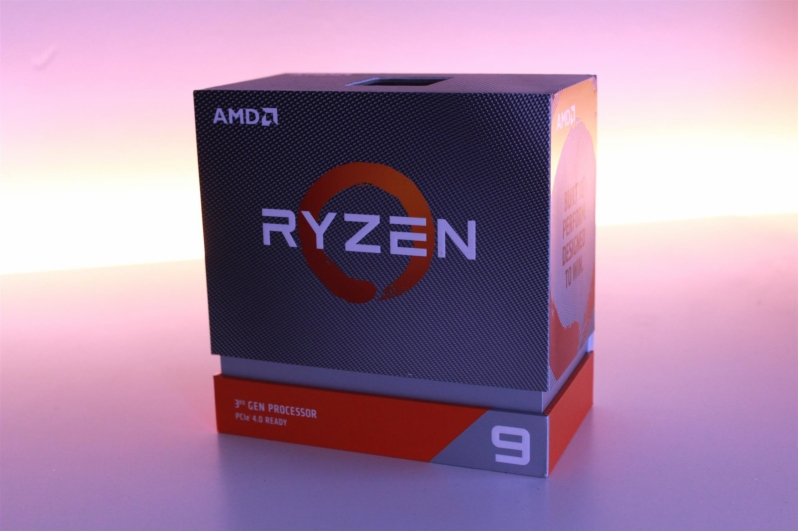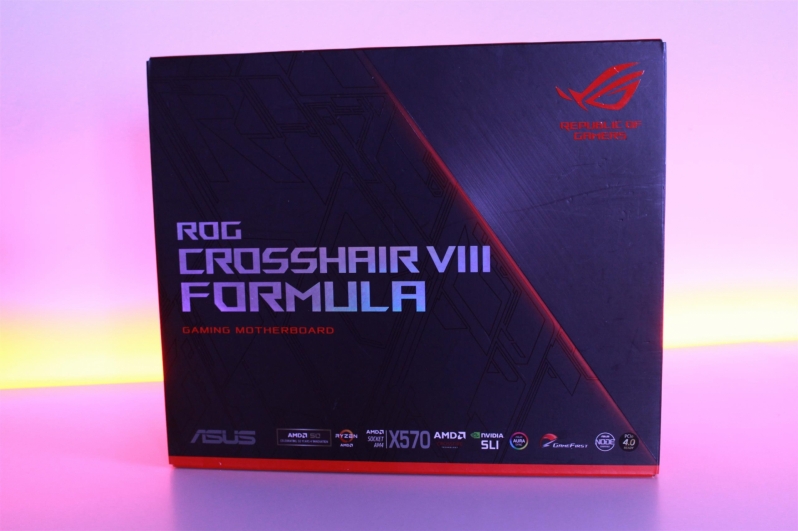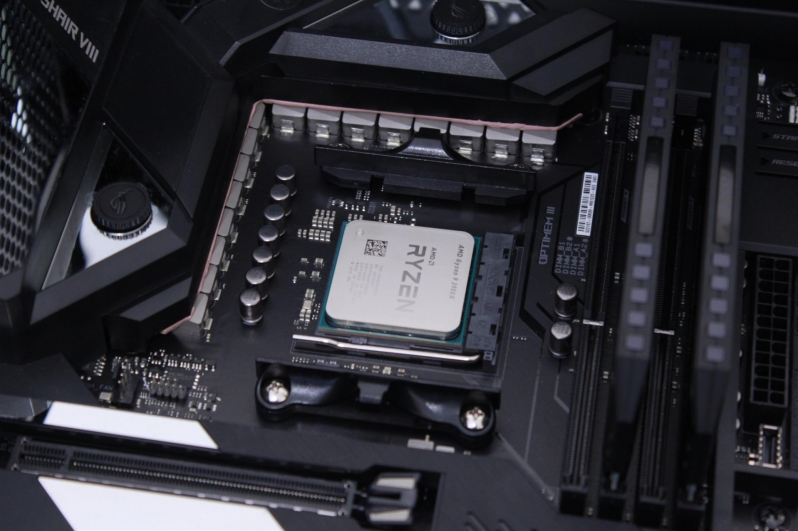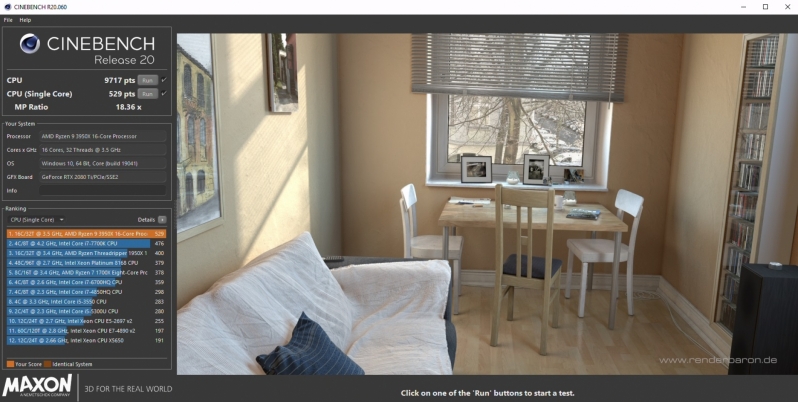Moving our GPU testing to AMD Ryzen
CPU and Motherboard Selection – Why we chose AMD and X570
CPU Selection was always going to be a controversial decision when building this test rig. Intel fans on one side will be shouting that “Intel is Best for Gaming”, while AMD fans will cry that “Only AMD offers PCIe 4.0”.Â
There was no simple answer to our question of “which CPU?”. Both brands have their upsides and downsides. AMD’s latest offerings tend to be more power-efficient, while Intel’s offerings tend to offer the highest raw performance levels in many scenarios.
Why Zen?Â
Looking ahead, we felt that AMD could provide us with the strongest base to create our next-generation testing platform. As mentioned above, only AMD could offer us PCIe 4.0 support; and as the CPU architecture behind both next-generation consoles, it is clear that AMD’s Ryzen (Zen 2) feature set will be heavily utilised within next-generation titles.
With both the Xbox Series X and PlayStation 5 offering consumers eight Zen 2 cores and sixteen total threads, it seemed clear to us that future PC games will start making use of higher CPU core counts. With this in mind, we decided to utilise AMD’s strongest mainstream desktop processor, the Ryzen 9 3950X.Â
When compared to our prior GPU test rig, which was powered by an Intel i7-6850K, our new Ryzen-based test system offers ten more cores and twenty more threads than the system it replaces.
While this system is overkill for today’s gaming needs, we hope that this high core/thread count will meet the needs of future games as future titles grow to utilise the high core/thread counts on PlayStation 5 and Xbox Series X.
With the AMD Ryzen 9 3950X, we will have a core for every thread that next-generation systems offer and the highest boost clock speeds that AMD can currently provide.Â
Another factor that’s worthy of consideration is AMD’s strong sales to today’s PC builders. That fact alone makes Ryzen-based testing valuable to readers, though that wasn’t our primary consideration.Â
PCIe 4.0 Support
With the next generation of consoles on the horizon, two things are clear. The first is that storage speeds will soon start to become a limiting factor within future AAA games, and the second is that more data than ever will soon be delivered too and from system memory and GPU frame buffers.Â
AMD’s current-generation graphics cards already support PCIe 4.0, and Nvidia’s upcoming Ampere architecture will also support the standard. With that will come the ability to test PCIe 4.0 VS PCIe 3.0, allowing us to judge whether or not PCIe bandwidth can be a performance-limiting factor for next-generation graphics hardware. Right now, only AMD can offer us that testing opportunity, giving us a clear reason to use Ryzen.Â
Another reason to use PCIe 4.0 is that it will allow us to utilise today’s fastest solid state drives (SSDs), another factor which could become important as games start to stress the NVMe SSDs within both next-generation consoles.Â
Microsoft has also created a new storage API called DirectStorage, which is due to become available to game developers next year. This standard will allow game developers on PC and Xbox Series X to deliver “high-performance next generation gaming IO” with NVMe storage. If developers start using the API to its fullest potential, PC games will start requiring ultra-fast NVMe SSDs, and today’s fastest SSDs operate using the PCIe 4.0 interface.
Since we have committed to using PCIe 4.0, we will need to use a compatible AMD motherboard. For that, we can use AMD’s B550 and X570 platform. Given the platform’s increased versatility, we opted to use an X570 motherboard. Specifically, we are using ASUS’ ROG Crosshair VIII Formula.Â
Â
ROG Crosshair VIII Formula
I know what you are thinking. We could have used a cheaper X570 motherboard. You are right, but when it comes to testbed systems, it usually pays to go premium.Â
Our test systems will go through hell and back several times before they retire. VRMs will be stressed, PCIe brackets will be strained, and the system will have to go through more hardware changes than one should reasonably expect from a motherboard.
Game tests will require us to test ten or more graphics cards within a short timeframe, and graphics card launches will see our offices temporarily fill with graphics cards as each vendor asks us to test their latest designs. Over a year, our test systems could have their graphics cards replaced hundreds of times. With that kind of use case, going cheap isn’t an option.Â
Another factor behind our motherboard selection is that we wanted to ensure that our system’s VRMs were strong enough to handle sustained workloads without much hassle. If all sixteen cores of our Ryzen 9 3950X processor are utilised, we want to be sure that this system can handle the strain with ease, even after years of heavy usage. We don’t want to replace this motherboard anytime soon. Â
Other perks of premium motherboards include their generous allotment of possible USB connections, their inclusion of POST code readers, and their support for the latest connectivity standards. These features can be incredibly useful when transferring large amounts of data and diagnosing potential system errors. When time is of the essence, these features can be invaluable.Â
Precision Boost Overdrive
To maximise our CPU’s performance, we have decided to enable AMD’s Precision Boost Overdrive technology on our Ryzen 9 3950X processor, allowing us to boost the performance of our system without placing the same strain on our components as traditional overclocking techniques.Â
When compared to a Cinebench score of around 9000 points on our stock system, we are now able to achieve scores of over 9700 consistently. Another bonus of this is that we do not lower the maximum levels of single-threaded performance that our processor can offer, which is possible with traditional all-core Zen 2 overclocks.Â
This change will help prevent our GPU testing from becoming CPU bound, which is a significant concern when testing ultra-high-end graphics cards at resolutions like 1080p.Â







